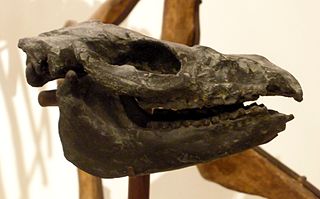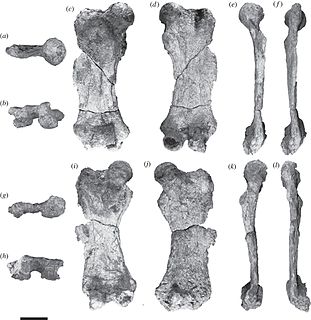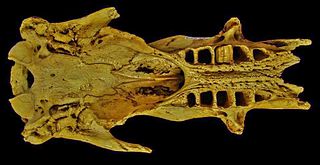Related Research Articles

Hapalops is an extinct genus of ground sloth from the Early to Late Miocene of Brazil, Bolivia, Colombia, and Argentina in South America.

Theosodon is an extinct genus of litoptern mammal from the Early to Middle Miocene of South America.
The Laventan age is a period of geologic time within the Middle Miocene epoch of the Neogene, used more specifically within the SALMA classification in South America. It follows the Colloncuran and precedes the Mayoan age.

Octodontotherium is an extinct genus of ground sloth of the family Mylodontidae, endemic to South America during the Oligocene-Early Miocene (Deseadan). It lived from 29—21 mya, existing for approximately 8 million years.
Guiomys is an extinct genus of cavioid rodent which lived in west central Patagonia of Argentina, Bolivia and Peru during the Middle Miocene (Laventan). Guiomys is known from mandibular and maxillary fragments with molars, and isolated cheek teeth. It was first named by María E. Pérez in 2010 and the type species is Guiomys unica.
Mionothropus is an extinct genus of nothrotheriine nothrotheriid sloth which existed in Peru in the western Amazon Basin, during the late Miocene. It is known from the holotype LACM 4609/117533, which includes cranial remains, recovered from the riverbank deposits of the Iñapari Formation in the Río Acre region, were originally assigned to Nothropus priscus. It was first named by Gerardo De Iuliis, Timothy J. Gaudin and Matthew J. Vicars in 2011 and the type species is Mionothropus cartellei. The generic name is derived from "Mio", is a reference to the Miocene provenance of the holotype, and "nothropus" refers to the initial allocation of the holotype to this genus from the South American Pleistocene. The specific name honours Dr. Castor Cartelle.

Proterotheriidae is an extinct family of fossil ungulates from the Cenozoic era that displays toe reduction. Despite resembling primitive, small horses, they were not related to them, but belonged to the native South American ungulate order Litopterna.

Granastrapotherium is an extinct genus of ungulate mammals, described from remains found in rocks of the Honda Group in the Tatacoa Desert, in the Colombian departments of Huila and Tolima, at the Miocene fossil site La Venta. The only species formally recognized is Granastrapotherium snorki. Remains found in Bolivia and Peru, seem to belong to Granastrapotherium or a very similar animal.

Xenastrapotherium is an extinct genus of astrapothere, a type of hoofed herbivorous mammal, native to South America, which lived in the Middle to Late Miocene period, typically during the Laventan stage. It is a member of the family Astrapotheriidae in the subfamily Uruguaytheriinae, large astrapotheres, equipped with a trunk-like nose and protruding teeth, similar to the elephants, but their tusks were the canine teeth, not the incisors. Xenastrapotherium was a genus widely distributed in northern South America, in contrast to other species of astrapotheres which lived in the area of the Southern Cone of the continent. It differed from other astrapotheres by having two lower incisors on each side of the jaw and the tusks have a pronounced longitudinal curvature, although their general shape and size are probably very similar to Astrapotherium, whose weight would be 900 to 1,500 kilograms, comparable to the current black rhino.
Galbula hylochoreutes is an extinct species of jacamar, small birds of the order Piciformes. It was discovered in the La Victoria Formation of the Honda Group, at the Konzentrat-Lagerstätte of La Venta in modern Colombia, in deposits dated to the Laventan period.

Propalaehoplophorus, also written as Propalaeohoplophorus, is an extinct genus of glyptodont, which lived in South America during the Early Miocene epoch.
Hondalagus is an extinct genus of marsupial mammals that lived during the Middle Miocene epoch (Laventan) in South America. Their fossils were found in the Honda Group at Quebrada Honda, in southern Bolivia. Hondalagus represents the smallest and most specialized member of the extinct family Argyrolagidae.

Nothrotheriidae is a family of extinct ground sloths that lived from approximately 11.6 mya—11,000 years ago, existing for approximately 11.49 million years. Previously placed within the tribe Nothrotheriini or subfamily Nothrotheriinae within Megatheriidae, they are now usually placed in their own family, Nothrotheriidae. Nothrotheriids appeared in the Tortonian, some 11.6 million years ago, in South America. The group includes the comparatively slightly built Nothrotheriops, which reached a length of about 2.75 metres (9.0 ft). While nothrotheriids were small compared to some of their megatheriid relatives, their claws provided an effective defense against predators, like those of larger anteaters today.

Eionaletherium is an extinct genus of ground sloth from the Late Miocene coasts of Venezuela containing one species: E. tanycnemius.
Potamosiren is an extinct genus of manatee from the Middle Miocene (Laventan) Honda Group of Colombia.

Diabolotherium is an extinct genus of indeterminate megatherioid sloth, known from the Late Pleistocene of Peru. Unlike most other extinct mainland sloths, it seems to have been a climber, similar to extinct sloths from the Caribbean. Fossils of the genus were found at the coastal Piedra Escrita site and the Andean Casa del Diablo cave.
Miocallicebus is an extinct genus of New World monkeys from the Middle Miocene. Its remains have been found at the Konzentrat-Lagerstätte of La Venta in the Honda Group of Colombia. The type species is M. villaviejai.
Patasola is an extinct genus of New World monkeys from the Middle Miocene. Its remains have been found at the Konzentrat-Lagerstätte of La Venta in the Honda Group of Colombia. The type species is Patasola magdalenae.

Miocochilius is an extinct genus of small notoungulate mammals (typotheres) native to South America. The genus lived during the Middle Miocene epoch. The genus contains two described species, the type species M. anomopodus described in 1953 by Ruben Arthur Stirton and M. federicoi, described and included in the genus by Darin A. Croft.
References
- ↑ Hiskatherium at Fossilworks.org
- ↑ Pujos, F.; Iuliis, G. de.; Quispe, B.M. (2011). "Hiskatherium saintandrei, gen. et sp. nov.: an unusual sloth from the Santacrucian of Quebrada Honda (Bolivia) and an overview of middle Miocene, small megatherioids". Journal of Vertebrate Paleontology. 31 (5): 1131–1149. doi:10.1080/02724634.2011.599463.

